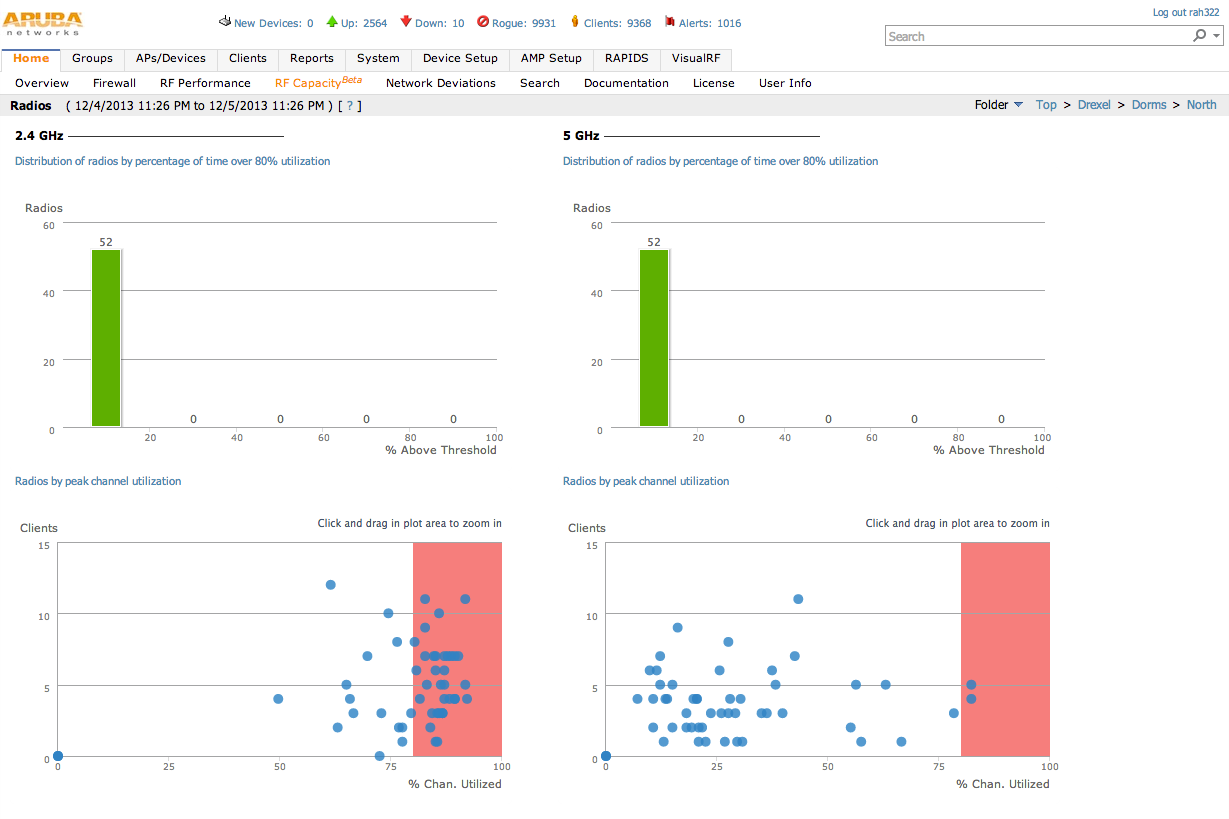Thank you,
Yeah, I found that command in one of the knowledge base articles after a bit more searching. Didn't know about the 4k cap, which is good to know.
(controller1) # show ap band-steering-clients
5GHz Capable Clients:3071
04:54:53:71:e1:00
a8:86:dd:e6:64:00
f4:f5:a5:b3:e2:80
…
That command by itself isn't terribly useful. However, w/ a little bit of cli-fu, we can gather a list of connected 2.4 GHz g clients that are 5 GHz capable.
(controller1) #show ap association phy g | include dragonfly3
stil-a-05c6 00:1a:1e:20:5c:60 60:c5:47:4b:86:33 y y 4 20 dragonfly3 431 0x13c0 g 6h:58m:4s 1 WA
stil-5-05a6 00:1a:1e:20:5a:60 b0:aa:36:ff:10:3e y y 1 10 dragonfly3 431 0x130e g 1m:17s 1 WA
stil-8-056a 00:1a:1e:20:56:a0 ec:55:f9:c4:b8:39 y y 1 0 dragonfly3 431 0x1346 g 1h:31m:46s 1 WA
…
Used awk to gather the clients' MAC address.
$ awk '{print $3}' "df3 g clients.txt" > df3_g_clients.txt
Sort both files.
$ sort df3_g_clients.txt > df3_g_clients_sorted.txt
$ sort "5GHz capable clients.txt" > 5ghz_capable_sorted.txt
Finally use comm to find the commonalities.
$ comm -12 5ghz_capable_sorted.txt df3_g_clients_sorted.txt
18:af:61:ee:68:ba
40:0e:85:67:c2:76
5c:0a:5b:a6:f8:bf
5c:0a:5b:f4:09:26
cc:78:5f:1c:d7:34
$ wc -l df3_g_clients_sorted.txt
60 df3_g_clients_sorted.txt
So, out of the 60 clients connected to our enterprise SSID, only 5 of them (according to the output of "show ap band-steering-clients") are capable of 5 GHz connectivity. I did the same test for our guest network & non-5 GHz network for older devices & came up w/ the same results. So I assume that the B: Band Steerable flag seen in the output of "show ap associations" is right on, in that those client w/ that flag are 5 GHz capable.
I've read just about all of the HighDensity VRDs & have come up w/ the same conclusions.
"At 5 GHz, the appropriate range is from 15 dBm to 18 dBm." - we're actually going to let 5 GHz roam the full range.
"The 2.4 GHz power range is set from 9 dBm to 15 dBm, then ARM analyzes and determines which 2.4 GHz radios to enable." - still working on the mode-aware bit.
Out of 66 APs, 19 are currently using 6 dBm transmit power in 2.4 Ghz. Coverage from VisualRF Heatmaps looks acceptable, and we've already gotten positive feedback from occupants in the building.
We'll look into setting it back to 9 dBm & turning on mode-aware ARM. I'm actually waiting to hear back from our Aruba team for their recommendations. Do you recommend simply running w/ mode-aware ARM enabled fulltime or can one enable it for a short while to get an idea of what radios to turn of and then set them to AirMonitors manually? Additionally, I think we'll need to disable client-aware ARM in order for any changes to take place. This is something that we're still coming to terms w/ & trying to stratergize what is the best way to do so w/ minimal disruption to clients. Your views, opinions, & recommendations would be greatly appreciated.
We already use HT20 & HT40 channels on the 5 GHz spectrium. Guest SSID is already 2.4 GHz only, however we've been told from Aruba that we should consider enabling 5 GHz in Guest.
Yes, we've got Airwave (7.7.1; yeah, I need to upgrade) & we're using it to see Utilization. We're really happy w/ the RF Capacity tab & we're using it to see before & after channel utilization for all APs in a building / group; although it takes one a while to wrap their head around the top graph's description. We've started taking screen shots to record before & after results once changes are made.

Most of our residence halls have 50% or more of their APs in the 80% Channel Utilization red zone for 2.4 GHz; very few radions over 20% of time over 80% utilziation. Most of the deployments mimic the "Microcel Reference Design #2 - Low Attenuation" that is described in the Next Gen Wireless Arch for Multimedia-Grade Residence Halls AppNote.
A few other things I'm considering : disabling basic rates in 2.4 GHz (although I hear it may cause issues w/ older clients & gaming consoles), enable local probe request threshold (25 dB), use airtime fairness (either fair or preferred), enabling broadcast filter-arp & broadcast filter all on the vap profile.
The main thing we're working on now is our identifying which buildings to make changes in given their deployment, utilization, attenuation, making sure we have proper profiles in place for RF & ARM, & deciding on what changes we actually want to make & how to best implement them. Oh, & as usual; documentation, documentation, documentation.
Thanks,